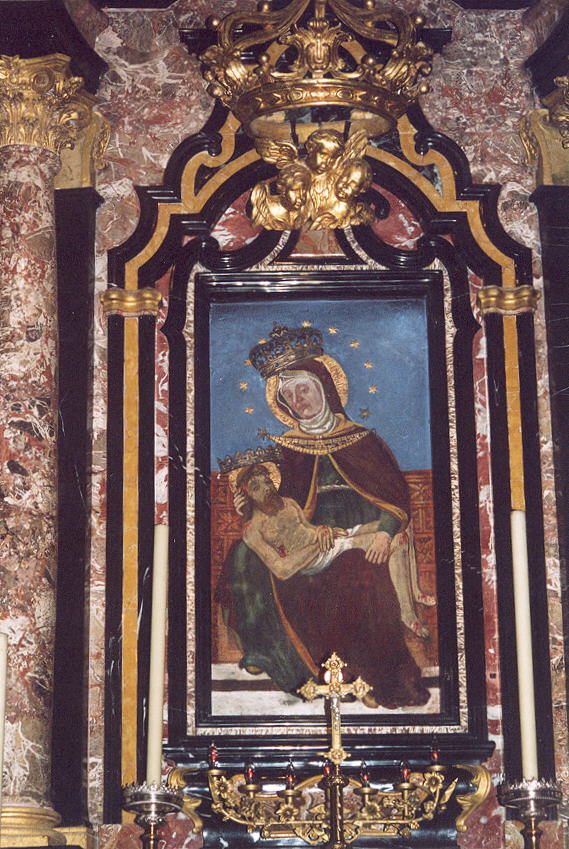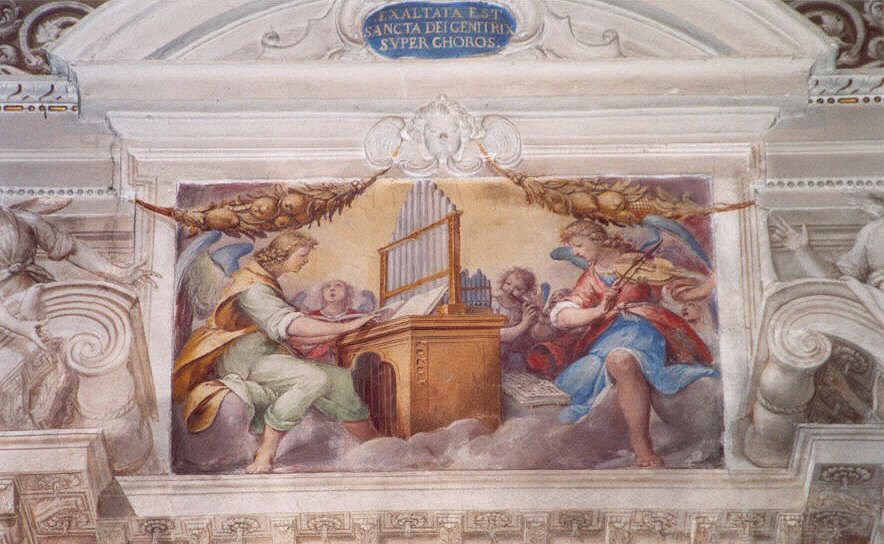1677 Michel Carboni Organ
Santuario Nostra Signora della Caravina, Valsolda/Como, Italy
Short Introduction and History
The organ is located in a middle-sized baroque church in Valsolda/Italy near Lugano. Due to large amount of marbled walls, the architecture has surprising acoustical properties with a rich and long reverberation. The organ was built by a the Ticinese organ manufacturer Michele Carboni in 1675 to 1677. The original room ambience with a reverberation time of about 4 seconds and the original tracker noises are captured precisely within this project.
This instrument is a typical historical Italian organ, which normally has one manual and a small pedalboard compass, serving only as a bass fundament. Italian historical organs normally serve especially for liturgical purposes and accompaniment of the choir, thus being not a special solistic instrument . There are no combined stops, such as mixtures with a common repetition scheme found in other European organs. The overtone stops are realized as separate Principal ranks (very often up to 1/8 ') which only repeat in high keys, such having the ability to built very special tonal structures and mixture-like sounds. A typical stop is the "Voce umana", which is not a reed stop, but a special slightly detuned pipe rank for chorus like effects. Italian organs are based on sonouros and warm Principal ranks and additionally have high and powerful overtone ranks for harpsichord like sounds. The organ has relations to Antegnati sound characteristics, having bright and rich overtones (compare the Venetian Callido 18th type).
Another special feature is the "Terzo mano" (third hand), an intra-manual octave coupler, which leads to an extraordinary full sound, but which was probably first added in 18th or 19th century and shouldn't normally be used for 17th century music.
Unfortunately the organ was set to equal temperament in the 19th century. To get back its 17th century sound, we decided to set back the organ to mean tone temperament. The organ now can again be heard in its probably most authentic sound.
The Carboni organ is in a very good shape due to a lot of pilgrim donations for the Santuary.
See Location in Googlemaps
Recording technique
The organ was recorded in September 2003 with 44 kHz, 16 bit, multi-channel for Hauptwerk 1
Virtual Console
Specification
Organ temperament:
Equal temperament at a1=440 Hz unfortunately probably sice 19th century
The virtual organ was therefore set back to mean tone temperament!
Manual compass:
F, G, A - g2, a2
Pedal compass:
C - d
c - d repeated from lower octave
Pedal fixed coupled to manual
Note:
The Carboni organ sound is based on Principale 16' (historically named: Principale 12', beginning at F)
but the F, G, A keys are not present on modern organ compasses. Therefore organist Fabio Mancini defined a historically renamed and reorganized version (stop names based on Principale 12', voce umana based on P12) playable in modern organ manual compass (beginning at C)
The Terzo Mano octave coupler was probably added in 18th or 19th century
Actual stop list (stop names based on Principale 8', voce umana based on P8):
|
Main |
Mnemo |
Modern |
|
|
1 |
Principale 16' (c) |
P16 |
16' |
|
2 |
Principale 8 ' |
P8 |
8' |
|
3 |
Ottava 4' |
O4 |
4' |
|
4 |
Duodecima |
XII |
2 2/3' |
|
5 |
Quintadecima |
XV |
2' |
|
6 |
Decimanona |
XIX |
1 1/3' |
|
7 |
Vigesimaseconda |
XXII |
1' |
|
8 |
Vigesimasesta |
XXVI |
2/3' |
|
9 |
Vigesimanona |
XXIX |
1/2' |
|
10 |
Flauto 8' |
FlVIII |
|
|
11 |
Flauto in XII' |
FlXII |
5 1/3' |
|
12 |
Voce umana (f#1) |
Voc |
Chorus |
|
13 |
Contrabassi 16' |
Cb16 |
Pedal |
|
14 |
Terzo mano |
Tm |
Octave Coupler |
Historically renamed and reorganized stop list by Fabio Mancini (stop names based on Principale 12', voce umana based on Principale 12'):
|
Main |
Mnemo |
Modern |
|
|
1 |
Principale 12' (C) |
P12 |
8' |
|
2 |
Ottava 6 ' |
O6 |
4' |
|
3 |
Quintadecima |
XV |
2' |
|
4 |
Decimanona |
XIX |
1 1/3' |
|
5 |
Vigesimaseconda |
XXII |
1' |
|
6 |
Vigesimasesta |
XXVI |
2/3' |
|
7 |
Vigesimanona |
XXIX |
1/2' |
|
8 |
Trigesimaterza |
XXXIII |
1/3' |
|
9 |
Trigesimasesta |
XXXVI |
1/4' |
|
10 |
Flauto in VIII |
FlVIII |
4' |
|
11 |
Flauto in XII' |
FlXII |
2 2/3' |
|
12 |
Voce umana (f#1) |
Voc |
Chorus |
|
13 |
Contrabassi 16' |
Cb16 |
Pedal |
|
14 |
Terzo mano |
Tm |
Octave Coupler |
Available organ definition files:
Carboni-P12-Meantone:
Modern adapted manual compass (C- g2, a2).
NOTE: Historically renamed stops, Voce umana compass shifted one octave (adapted to most ancient Italian organ music). Reduced manual compass beginning with Principale 12‘ at C (usual modern organ console compass), thus F-B are not playable!!
Carboni-P12b-Meantone:
Original manual compass (F, G, A - g2, a2).
NOTE: Complete original manual compass shifted one octave to be able to play all notes on modern organ consoles (F - a2), but one octave higher than usual!
Requirements
Loaded Version |
Memory Requirements 3) |
Processor Speed |
|
16-bit, compressed1) |
850 MB |
≥ 1,2 GHz SingleCore 2) |
1) Lossless compression (no loss of sound quality!)
2) Recommended:
Minimal configuration:
Single-Core, 2 GByte main memory, WIN-XP, Vista, Windows7 or MAC OS
3) To load this organ into Hauptwerk you will need enough free memory in your computer, due to the amount of playable stops, not including the operating system or any other programs that may be running!
We recommend the professional audio card RME HDSP 9632 and the AKG Reference Headphone K701 for optimal sound and room impression.
Demos
The following demo pieces were recorded with the Hauptwerk1 software and the virtual organ sample set, with no additional effects processing.
Girolamo Frescobaldi (1583-1643)
Toccata avanti la messa I,1 1) 1:23 min
Stop list: (historically modified version, see Specification)
P12, O6, XV, XIX, XXII, XXVI, XXIX, Fl VIII, Cb16
Toccata cromatica per l'Elevazione, Messa I, 5 1) 3:27 min
Stop list: P12, Voc, Cb16
Toccata Messa III, 7 1) 0:55 min
Stop list: Fl XIII
Antonio Cabezon (1510-1566)
Tiento del secondo modo 2) 3:44 min
Stop list: P12, O6, Fl VIII, Fl XII
Juan Bautista José Cabanillas (1644-1712)
Tiento de falsas 3) 2:08 min
Stop list: P12, O6, XV, Fl VIII
Sources:
1) MIDI file S. Gheller
2) MIDI file Simonetto
3) MIDI file McCoy
© OrganART Media, all rights reserved
No demo sounds may be used or transmitted in any form for public purposes without the prior permission of the publisher!








